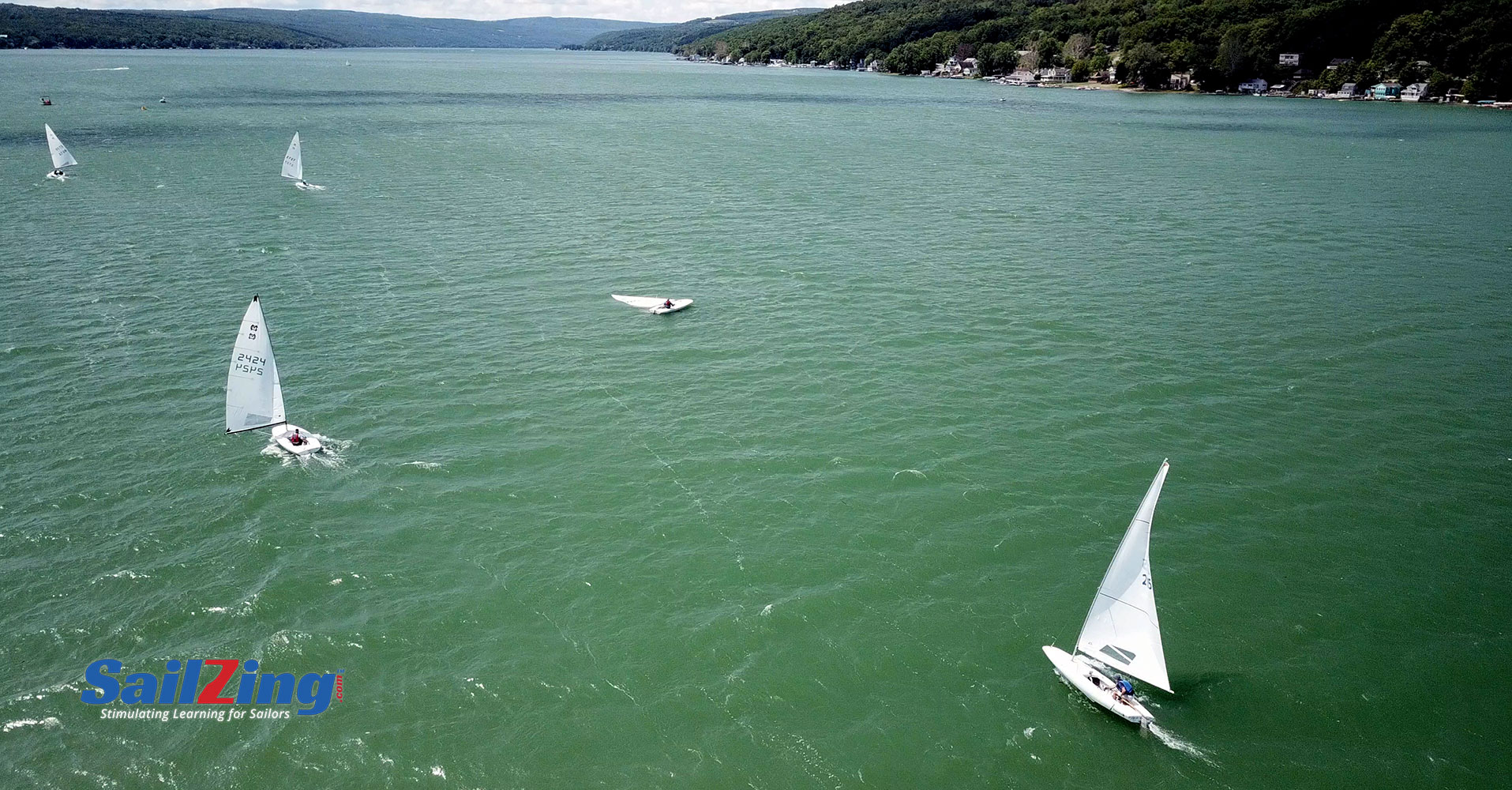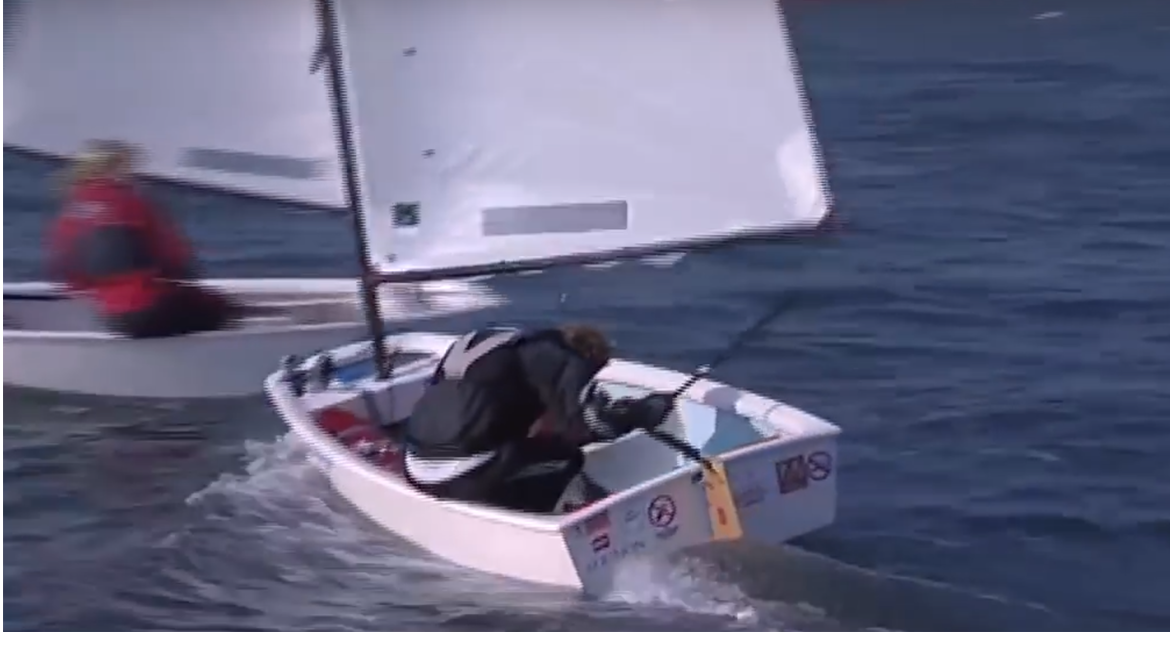Are you afraid of heavy air gybes (or jibe) due to either lack of experience or too many painful experiences? We asked Zack Clayton – a top scow sailor and sailcloth industry leader with Dimension-Polyant – to share his thoughts on heavy air gybes. Zack is known for his ability to survive and go fast in heavy air.
Zack’s description is based on the MC Scow, but most of the techniques apply to other non-spinnaker boats. Thanks to John Porter for adding insights.
Heavy Air Gybes in the MC Scow
Although you may only perform 3-6 gybes per race in a MC Scow, the risk/reward ratio is significant and varies depending upon the wind conditions. In light breeze, the loss of boat speed and long re-acceleration time has to factor into the decision of when and how often to gybe the boat. As the wind increases, the loss of speed is reduced, but the risk of going for a swim increases.
The basic mechanics of an MC Scow gybe do not change dramatically over the range of wind conditions but there are a few techniques that can improve all of your gybes as well as reduce the risks of ending the day with an unexpected swim or watching the fleet sail by while you are pushed out to a corner, afraid to perform this sailing maneuver.
Gybing Mechanics
- Look behind the boat to see what breeze (velocity and angle) you are gybing into.
- Try to perform a gybe when boat speed is up, rather than when going slow.
- Slowly bear away to a full downwind position.
- Sheet in one to three arms length of mainsheet.
- As leech of sail starts to break, give a final flick of the mainsheet.
If you have sheeted in and were heading dead downwind, this may be enough to get the main to cross. If not, turn down slightly. The key is to avoid oversteering. - As boom crosses midline, center the tiller to avoid oversteer.
If you don’t center the tiller quickly enough, you will end up on a reach and possibly round up and capsize. Ending up on a very slight reach (just above dead downwind) is more stable than dead downwind, but any further is dangerous. For more, see the section on steering for balance below. - Switch sides of the boat – later in light air, sooner as the breeze increases.
- Ease mainsheet and switch hands.
- Position new board and pull up opposite board.
Watching Laser sailors gybe is very similar to what a MC gybe should look like.
In light and medium breeze you do not have waves, large velocity changes, huge penalty for oversteer, etc. We MC sailors tend to be lazy and we can gybe the boat by grabbing the sheet line above the traveler and tossing it across – I do it too – but it can build bad habits that get us into trouble when the breeze increases, as the proper techniques in normal conditions will reduce risk in wild conditions.
When things go wrong, and right…
Plan Ahead for Heavy Air Gybes
As the wind velocity increases near the MC Scow racing limit (18-25 mph) the gybe becomes one of the most dangerous maneuvers in the race. To reduce the risk of capsize, I utilize a few adjustments to reduce the risk.
#1. Plan your downwind leg early
A gybe in the top third of the course for scow sailing almost always has smaller waves and less velocity than the bottom third of the course.
- Utilize the top 1/8th of the upwind to decide on which gybe you want to be on after the windward mark.
- This will get you onto the best angle and best breeze to start the run.
- Avoid having to gybe around the leeward mark.
- Preparation is the key here – arriving at leeward mark overstood can make for a dangerous turn.
- (Ed. note): If you realize early that you will be on the wrong tack at the mark, use the rest of the leg to sail as low as possible, including by the lee if necessary.
- Depending upon fleet size and gate options the wrong gate may be a better choice than a hairpin gybe.
- A controlled rounding is better than aborting the gybe or capsizing to save a couple of boat lengths.
#2. Gybe before big velocity increase arrives
If you see the fleet behind you on the opposite gybe and a big puff coming, the edge of the puff is almost always the strongest so if you want to gybe, do it early so you are prepared for velocity and angle changes.
#3. Plan your gybe for the top of a wave, rather than the swell (trough)
This allows for a bit more time and less risk. It also keeps the bow from steering into the face of the wave.
#4. Prepare the new board before the gybe, but less is more
- Get traveler on centerline – it may have been down for the upwind, but center it before gybing.
- I will have both boards down but less than 1/4 – more like 1/8.
- Too much board and oversteer and you can trip the boat on the board.
#5. Slow – Quick – Slow is the operation
- Slow turn down on the wave.
- Quick boom across and sit onto new high side with immediate return to center of tiller.
- Slow ease of mainsheet, hand switch and board adjustment.
Steering for Balance
Maintaining balance is tricky in heavy air downwind. In our post on Capsize Causes and Solutions, Part 2, – Off-wind Balance, we discussed steering for balance – steering so that the board in the water helps keep you upright. In short, you steer the boat under the rig, to prevent “tripping” over the board:
- If the rig heels to windward, head up.
- If the rig heels to leeward, head down.

Using this principle, many sailors do an S-turn gybe in big breeze. This is OK, if you don’t oversteer. As soon as the boom crosses the boat, instead of simply centering the tiller, steer slightly toward the sail. This helps prevent rounding up, especially if you steered down excessively before the gybe and the sail is trimmed in too far on the new tack.
Practice and Enjoy the Experiences
Like most maneuvers in any sailboat, planning, preparation and practice are the keys to smooth execution of all aspects of a sailboat race. Steering the MC downwind in waves takes practice, experience and concentration. The more comfortable you become with downwind steering in the waves, the easier gybes will become. (Ed. note – practice with a masthead flotation panel!)
That being said, even the best sailors in our fleet have stories of deathrolls, chicken gybes and wipeouts. Some of my favorites come from the top of the fleet where everyone gets to enjoy the show – always remember to have the safety pin in the rudder just in case it all goes wrong!
Sailing Downwind in Waves – MC Scow
Capsize Causes and Solutions – Part 2: Off-wind Balance
Laser Sailing Top Tips – Gybing – with Double Olympic Gold Medallist Shirley Robertson
Gybing – Thoughts from Steve Cockerill, Frank Bethwaite… and me – Improper Course Blog



